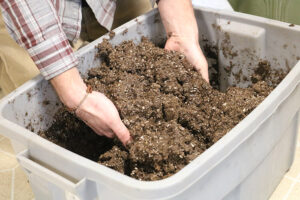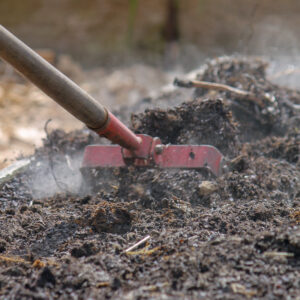Soil Health
A thriving, productive garden begins with healthy soil.
 A thriving, productive garden begins with healthy soil. Healthy soil is a combination of minerals (of sand, silt, and clay), rock, water, air, and organic matter (plant and animal residue), as well as an abundance of diverse microorganisms (bacteria, fungi, algae, worms, and arthropods). These organisms sustain an intricate, subterranean “food web,” recycling nutrients that provide a natural, steady, and reliable source of sustenance for growing plants. Because organic matter fuels and sustains this nutrient-recycling process, you’ll want to ensure your garden soil is fertile and has enough of the organic matter it needs.
A thriving, productive garden begins with healthy soil. Healthy soil is a combination of minerals (of sand, silt, and clay), rock, water, air, and organic matter (plant and animal residue), as well as an abundance of diverse microorganisms (bacteria, fungi, algae, worms, and arthropods). These organisms sustain an intricate, subterranean “food web,” recycling nutrients that provide a natural, steady, and reliable source of sustenance for growing plants. Because organic matter fuels and sustains this nutrient-recycling process, you’ll want to ensure your garden soil is fertile and has enough of the organic matter it needs.
Soil types range from sand to clay; soil that falls somewhere in the middle of these extremes is called silt or loam. Soil type determines what plant varieties will grow best in a given location, and can provide clues to how to manage your garden successfully. For example, sand is a very large particle, and makes soil porous, which means water moves very quickly through the soil. While this helps prevent flooding after a heavy rain, it also means a gardener may need to water plants more often as water travels out of plants’ root zones too quickly for plants to adequately absorb all of the moisture they need. On the other hand, clay soils are composed of very small particles and therefore have small pores, which generally means that drainage is poor. Small pores also provide less space for air in the soil, which makes these soils more prone to compaction, which can inhibit the growth of plant roots.
If many of the plants in your garden are suffering and no pest or disease problems are visible, soil health may be the issue. The first step in addressing soil health is to collect a soil sample. Your local extension office will likely be able to send a sample of your soil to a soil-testing lab. The test results will provide information about soil pH and nutrient deficiencies. Most vegetables prefer a pH between 6 and 7, so if your results fall within that range, pH is not the problem. To prepare samples for the lab, dig 6″–12″ deep, collect a sample of the soil, and put that sample in a clear plastic bag. If you have a larger garden, it’s a good idea to get a few samples from different sections of the garden; place those samples in separate bags and label the bags with the location from which each sample was drawn. Make sure the soil is air-dry before sealing the bag and sending it to your extension office.
A few key methods can help ensure soil is healthy for many gardening seasons to come. The first is to practice crop rotation. This means that you shouldn’t plant crops from the same family in the same place year after year. For example, eggplants, tomatoes, and peppers are all part of the Solanaceae family, so if you plant eggplant in a corner of your garden this year, next year you should avoid planting eggplant, tomatoes, and peppers in that spot. This helps reduce pest problems, but it also helps cut down on disease occurrences, as some diseases can remain in the soil for several years after being introduced.
 In addition to crop rotation, it’s a good idea to plant a cover crop in beds that are not in use. Some cover crops, such as red clover and hairy vetch, are especially good choices as they have high nitrogen content. At the end of the season, they are simply turned under and incorporated into the soil to provide nutrients for next year’s crops. Cover crops also function as a ground cover—reducing unwanted weeds and helping prevent soil from eroding when it rains. (Avoiding soil compaction, steering clear of synthetic fertilizers and pesticides, and minimizing tillage are all important to healthy soil as well.)
In addition to crop rotation, it’s a good idea to plant a cover crop in beds that are not in use. Some cover crops, such as red clover and hairy vetch, are especially good choices as they have high nitrogen content. At the end of the season, they are simply turned under and incorporated into the soil to provide nutrients for next year’s crops. Cover crops also function as a ground cover—reducing unwanted weeds and helping prevent soil from eroding when it rains. (Avoiding soil compaction, steering clear of synthetic fertilizers and pesticides, and minimizing tillage are all important to healthy soil as well.)
Finally, the importance of adding compost and other organic matter to soil cannot be understated. Compost increases available water in the soil, adds nutrients, reduces the need for fertilizer inputs, and helps with disease suppression. A garden soil that contains five to ten percent organic matter is ideal. Compost is the most familiar and popular soil-improvement amendment, but there are plenty of other materials that can provide soil with the organic matter it needs, including composted animal manure, cover crops, and mulch (such as shredded bark, straw, wood chips and leaf debris). Adding a layer of mulch in your garden aisles and around plants helps your soil retain water for longer and suppress weed growth.
 The amount of compost a garden needs depends upon many factors, beginning with the amount of organic matter it naturally contains and including the use of cover crops, mulch, and decaying plant material from the previous season. The recommended compost-application rate for a new garden or when restoring garden soil is 4″–6″ of organic matter per square foot. (Be sure to incorporate the compost deeply into your soil, up to 24″.) For existing garden maintenance, use two to three inches of compost per foot, being sure to incorporate the material into the top 8″–10″ of your soil.
The amount of compost a garden needs depends upon many factors, beginning with the amount of organic matter it naturally contains and including the use of cover crops, mulch, and decaying plant material from the previous season. The recommended compost-application rate for a new garden or when restoring garden soil is 4″–6″ of organic matter per square foot. (Be sure to incorporate the compost deeply into your soil, up to 24″.) For existing garden maintenance, use two to three inches of compost per foot, being sure to incorporate the material into the top 8″–10″ of your soil.
Organic matter does much more than sustain the subterranean “food web.” A short list of its myriad virtues in the garden includes improving drainage of heavy, poorly drained clay soils and conversely increasing the water-holding capacity of light, sandy soils; reducing compaction and erosion; improving soil structure and tilth (or workability); preventing plant-available nutrients from leaching out of the root zone; reducing the incidence of pests and disease and suppressing weeds.
The University of Minnesota Extension, the USDA Natural Resources Conservation Service, and Sustainable Agriculture Research and Education all offer detailed resources on cultivating healthy soil.
Watch the short video featuring SSE field operations coordinator Brennan Allsworth and evaluation manager Kate Rowe as they explain the four basic principles that help grow and maintain healthy soils.
Keep Learning